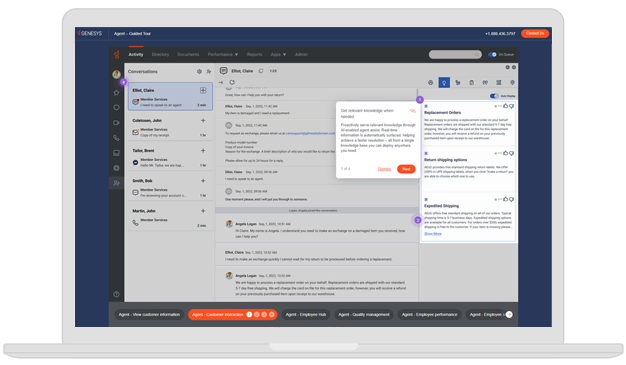
Introduction
The modern workplace demands agility. In contact centers and other fast-paced environments, employees need flexibility, and businesses need efficiency.
Flexible scheduling and shift bidding bridge this gap. They give employees control over their work hours while ensuring the business meets operational needs. These strategies not only improve workforce engagement but also help organizations deliver consistent, high-quality customer experiences.
Adopting flexible work models can be a game-changer. When employees feel supported in balancing work and life responsibilities, they become more engaged and productive. For companies, this translates to improved performance metrics, better retention and a more resilient workforce.
By empowering employees through flexible scheduling and shift bidding, businesses can foster a culture of trust, accountability and continuous improvement. In this article, you’ll learn how flexible work schedules and shift bidding empower teams, enhance operations and set the foundation for success.
Understanding flexible scheduling and shift bidding
Definition and importance of flexible scheduling
Flexible scheduling allows employees to tailor their work hours to fit personal needs and preferences, within the framework of operational requirements. Instead of a rigid 9-to-5 model, flexible scheduling supports variable start and end times, compressed workweeks, or even part-time roles. In contact centers and customer experience (CX)-focused environments, this approach is crucial for managing varying customer demand while respecting employees’ lives outside of work. It also reduces burnout, boosts morale and increases retention.
Flex scheduling supports employee autonomy and encourages accountability. By providing the tools and structure for employees to manage their time, companies can enhance job satisfaction and foster a sense of ownership. Flexible scheduling also opens the door to alternative work schedule models that accommodate employees across different time zones, further expanding a company’s talent pool and enhancing diversity in the workplace.
How shift bidding works in various industries
Shift bidding is a process where employees select preferred shifts based on availability, seniority, performance or other defined criteria. It ensures optimal coverage without micromanaging schedules.
Employees place bids on available shifts through digital platforms. A shift scheduler then assigns shifts based on the rules in place, such as a first-come, first-served policy or performance-based priority. This increases transparency and employee satisfaction.
Shift bidding work models can vary widely across organizations. Some use rotating priority lists, while others assign weighted scores to determine who receives preferred shifts. These systems are designed to ensure fairness and operational continuity.
Some companies use employee feedback to refine shift bid processes and improve the scheduling experience. Over time, these refinements result in a more engaged and balanced workforce.
Types of flexible schedules
Compressed workweeks and their benefits
A compressed workweek condenses a full-time workload into fewer days, such as four 10-hour days instead of five 8-hour days. This arrangement allows employees to enjoy an additional day off without reducing their total work hours. It’s particularly effective in environments where longer shifts can improve continuity and reduce shift handoffs, such as call centers or IT support desks.
Benefits of compressed workweeks include fewer commutes, improved work-life balance and increased productivity. Employees gain an extra day to rest, attend appointments or manage responsibilities, which can reduce stress and absenteeism. For businesses, this model can lead to higher engagement and fewer disruptions, especially when paired with clear expectations and performance metrics. It also reduces burnout and enhances overall job satisfaction.
Flextime and its impact on employee autonomy
Flextime gives employees control over their daily schedules, letting them choose when to start and end their shifts within agreed-upon limits. For example, an agent might choose to work from 7 AM to 3 PM instead of the standard 9 AM to 5 PM. Flextime enhances employee autonomy, making it easier to manage personal commitments and reducing stress. It also supports productivity by aligning work hours with employees’ natural energy peaks.
Flextime can also help reduce peak-hour congestion in physical workplaces and improve digital collaboration across time zones. When implemented effectively, flextime policies foster a sense of trust and empowerment.
Employees feel that management acknowledges their unique circumstances, which can translate into higher engagement and improved team morale. Companies can track outcomes using performance data, ensuring that flex scheduling supports both employee well-being and business objectives.
Shift swapping and employee satisfaction
Shift swapping allows employees to trade shifts with coworkers, either informally or through approved scheduling platforms. This adds flexibility without disrupting staffing levels. When employees have the ability to manage their schedules collaboratively, satisfaction and engagement increase. Shift swapping also helps teams cover unexpected absences, reducing the burden on managers and minimizing service disruption.
Digital shift swap tools provide real-time visibility into schedules, making it easy for employees to find swap opportunities and for managers to approve them. These systems often include built-in compliance checks to ensure labor law adherence. By reducing the need for last-minute managerial intervention, shift swapping streamlines operations and supports a more self-sufficient workforce.
The role of technology in flexible scheduling
Software solutions for managing shift bidding
Modern workforce engagement management (WEM) tools streamline the shift bid process. With these systems, employees can submit shift bids, track schedules and get notifications in real time. The software automatically assigns shifts based on the defined criteria, removing manual effort and bias. Shift bid systems improve accuracy, transparency and fairness in scheduling, which drives higher employee satisfaction and operational consistency.
Advanced systems also support predictive modeling, allowing organizations to anticipate staffing needs based on historical trends. These capabilities help organizations stay ahead of fluctuations in demand. Integration with other systems like payroll, timekeeping and human resources management creates a unified scheduling process that is accurate, efficient and scalable.
Mobile apps that facilitate flexible scheduling
Mobile scheduling apps empower employees to manage their schedules on the go. These apps allow team members to submit time-off requests, view upcoming shifts, bid on available shifts and swap shifts with peers.
The real-time nature of mobile apps increases responsiveness and reduces administrative overhead. For managers, it provides a dashboard to monitor compliance, manage staffing levels and make data-driven decisions.
Mobile apps also enable notifications and reminders, helping reduce missed shifts and improving adherence. Features like shift alerts and schedule change approvals ensure both employees and managers stay aligned. These digital tools make the scheduling process more efficient, while also supporting workforce transparency and accountability. In fast-paced industries like call centers, real-time updates can significantly impact service quality and operational continuity.
Benefits of flexible scheduling for employers
Increased productivity and operational efficiency
When employees have more control over their schedules, they tend to be more focused and energized during their shifts. Flexible work schedules reduce absenteeism and tardiness by aligning work hours with personal obligations.
This ensures that the time employees spend at work is more productive. In contact centers, improved adherence to schedules directly correlates with better service levels and customer satisfaction.
Flexible scheduling also supports better resource allocation. By offering alternative work schedules, managers can assign employees to shifts that match peak demand periods.
This helps reduce overstaffing during slower times and ensures the right number of employees are available during busy hours. The result is a scheduling process that meets business needs while maximizing employee output.
Enhanced employee retention rates
Flexibility is a key driver of employee retention. In a competitive labor market, offering flexible scheduling helps attract and retain top talent. Employees who can balance work and personal commitments are less likely to leave.
Shift-based scheduling that respects personal preferences and life events fosters loyalty and reduces turnover costs. This is particularly important in roles with high burnout potential, such as frontline customer support.
Retention also improves when employees feel they are treated fairly and have a say in their schedules. Providing tools that let employees participate in scheduling decisions demonstrates trust and investment in their well-being. When employees feel heard and supported, they become long-term contributors to the organization.
Benefits of shift bidding for employees
Greater work-life balance and job satisfaction
Shift bidding gives employees more control over when they work. This enables them to better manage responsibilities outside of work, such as caregiving, education or personal wellness.
Greater control leads to improved work-life balance and higher job satisfaction. Employees feel heard and valued, which increases engagement and motivation.
Shift bidding also helps eliminate scheduling surprises. Employees know what to expect and can plan accordingly. This predictability is crucial for reducing stress and creating a healthier work environment.
It also allows employees to pursue personal goals, such as continuing education or side projects, without compromising their job responsibilities.
Empowerment through schedule control
By participating in the shift bidding process, employees feel more involved in their work environment. This sense of control can increase accountability and morale. When employees choose preferred shifts, they are more likely to show up on time, stay engaged and deliver high-quality work. This empowerment helps build a culture of trust and transparency.
Empowered employees are also more likely to advocate for their workplace, contributing to a positive reputation that can enhance recruitment efforts. Giving employees agency over their time reinforces their role as collaborators in the company’s success. Over time, this can build stronger teams, decrease attrition and improve overall performance.
Challenges of implementing flexible schedules
Potential conflicts and how to resolve them
Introducing flexible work schedules can lead to scheduling conflicts or feelings of favoritism. To prevent this, clearly defined policies and transparent shift bid processes are essential. Employers should use scheduling tools that apply consistent rules and allow for appeals or feedback. Training managers to handle disputes fairly and proactively is also key.
Effective communication is critical. Employers must set expectations and regularly solicit employee input.
Transparency around how decisions are made builds trust and minimizes resistance. Encouraging open dialogue and continuous improvement helps organizations adapt to challenges and refine their processes over time.
Maintaining fairness in shift assignments
Fairness in shift bidding depends on the criteria used to allocate shifts. Seniority-based systems can cause friction among newer employees, while performance-based systems require accurate and unbiased evaluation metrics.
To maintain fairness, consider hybrid models that combine tenure, performance and availability. Regularly review outcomes to ensure the process aligns with employee needs and business goals.
Using data to evaluate shift outcomes also supports fairness. Monitor how shift assignments affect performance, attendance and morale.
Adjust processes based on what the data shows. By fostering a culture of fairness, companies can reduce internal conflict and create a more positive, inclusive workplace.
Conclusion
Flexible scheduling and shift bidding aren’t just operational strategies. They are foundational to a modern, agile workforce. They support both the business and the employee, enabling efficiency, adaptability and satisfaction. By leveraging digital tools and a fair scheduling process, organizations can build resilient teams equipped for success in the experience economy.
As customer expectations grow and the workforce becomes more diverse, offering flexibility isn’t just a nice-to-have — it’s a competitive advantage. Flexible work schedules empower employees to thrive and help companies exceed performance goals.
Shift bidding adds another layer of empowerment and fairness, reinforcing a culture that values choice, trust and transparency. Investing in flex scheduling shows your people they matter — and that you’re committed to their well-being as much as their output.
Questions
What are the common types of flexible schedules?
Common flexible schedules include compressed workweeks (e.g., four 10-hour days), flextime (variable start and end times), part-time roles and shift swapping. These models allow employees to customize their work hours while still meeting business needs. Depending on the industry, some businesses also adopt seasonal or remote shift models to manage peak demand and geographical dispersion.
How does shift bidding influence employee morale?
Shift bidding boosts morale by giving employees more control over their work hours. When workers can select preferred shifts, they feel more empowered and respected. This leads to increased engagement, accountability and job satisfaction. Employees who feel they have a say in their schedules are more likely to stay with their organization and contribute positively to team culture.
Can flexible scheduling work in all types of businesses?
While flexible scheduling is especially common in industries like contact centers, retail and healthcare, it can work in many businesses. Success depends on the right mix of tools, communication and planning. It’s important to align flexibility with operational goals. Even businesses with fixed operational hours can offer partial flex options, such as staggered start times or rotating shift models.
What are the legal considerations with flexible scheduling?
Flexible scheduling must comply with labor laws regarding hours worked, overtime, break times and fair scheduling practices. Some jurisdictions have predictive scheduling laws that require advance notice of shifts. Employers should consult legal counsel when designing schedules. Using compliant shift bid systems helps reduce the risk of regulatory violations and supports fair labor practices.
How to start implementing flexible scheduling in your company?
Start by assessing your operational needs and employee preferences. Use workforce management software to pilot a scheduling process that includes flexible options. Collect feedback, adjust policies and train managers to ensure fairness and compliance.
Gradual implementation helps build trust and refine the process. Continuous improvement and clear communication are essential for success.





